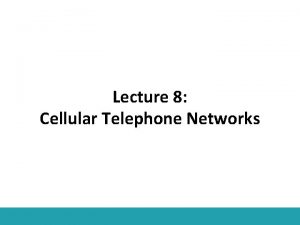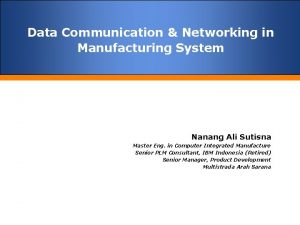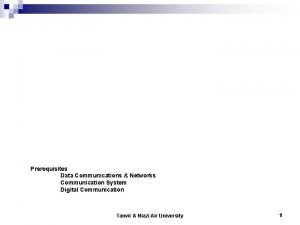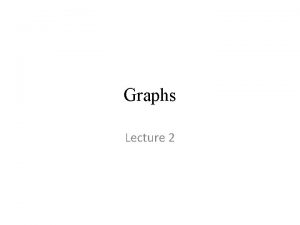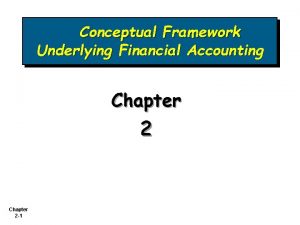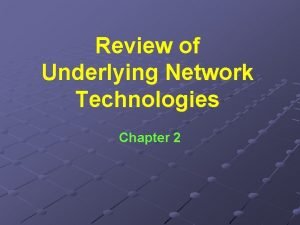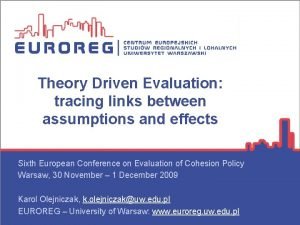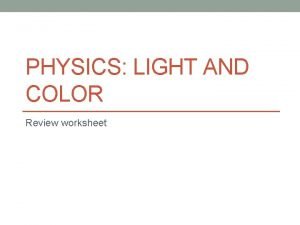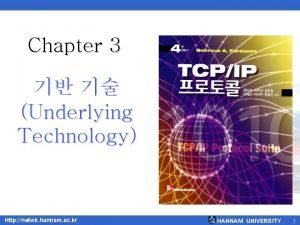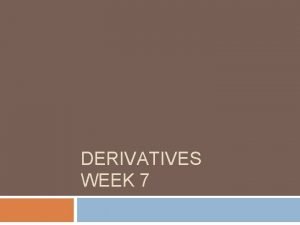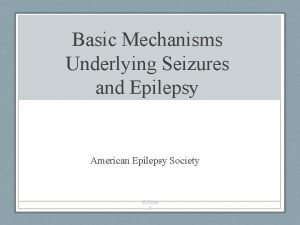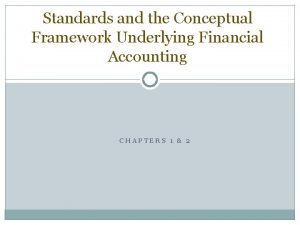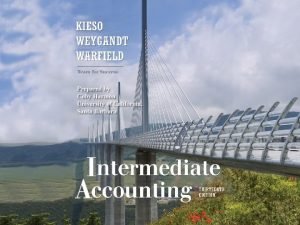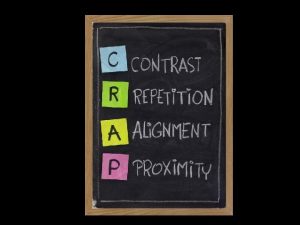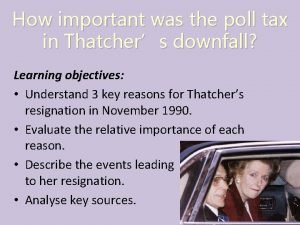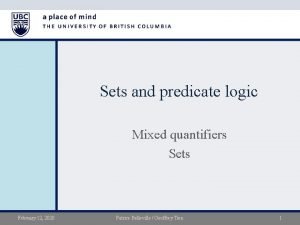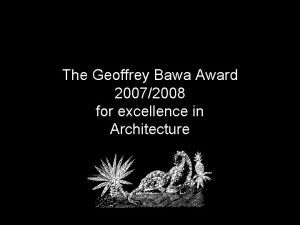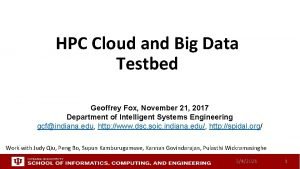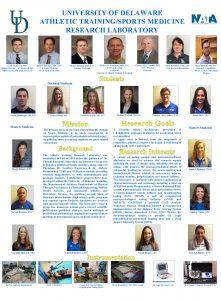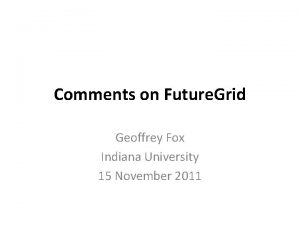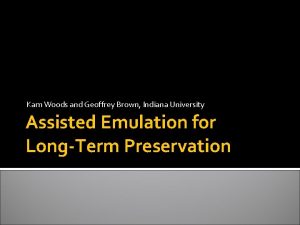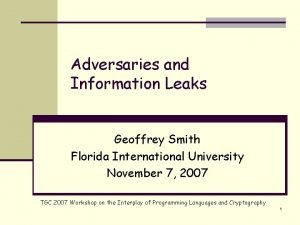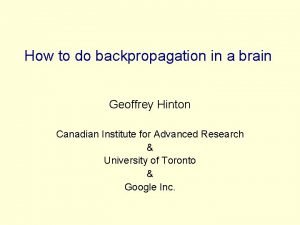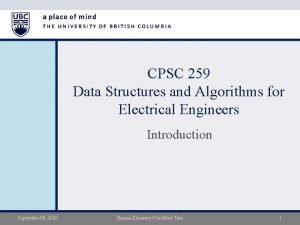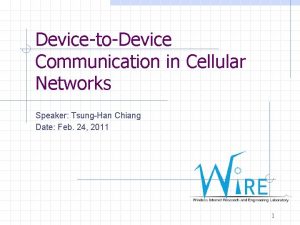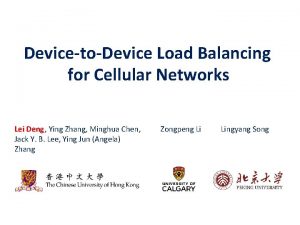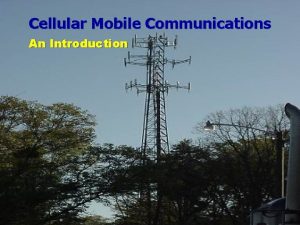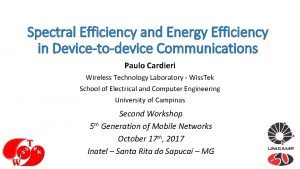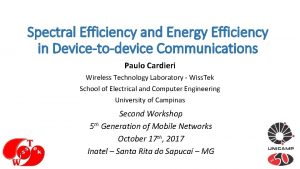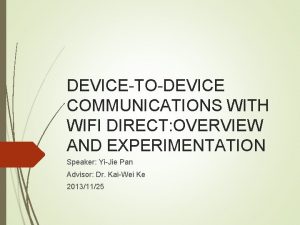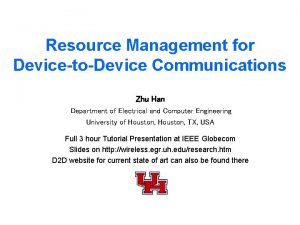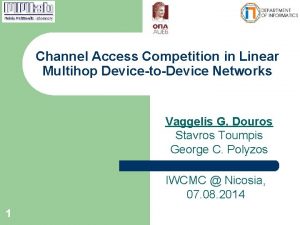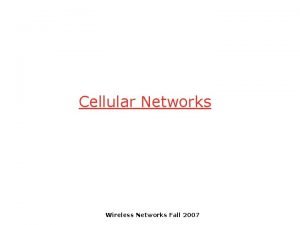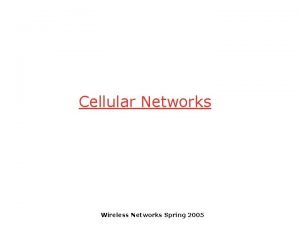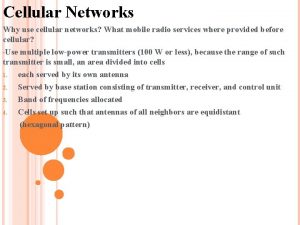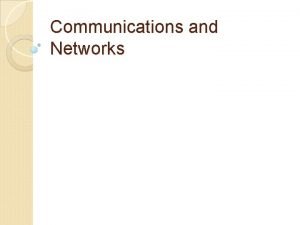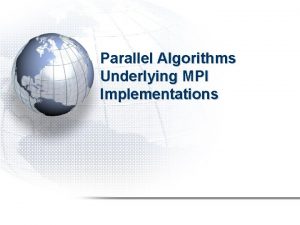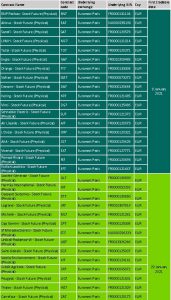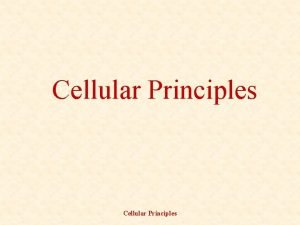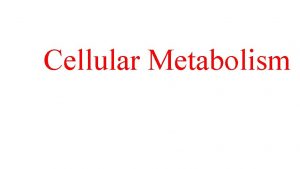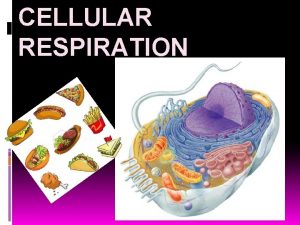DevicetoDevice Communications Underlying Cellular Networks Geoffrey Ye Li









































- Slides: 41

Device-to-Device Communications Underlying Cellular Networks Geoffrey Ye Li School of ECE, Georgia Institute of Technology

Outline • Why D 2 D Communications? • Topic 1: Qo. S-Aware Resource Allocation • Topic 2: EE/SE Mode Switching • Future Work 1/40

Why D 2 D Communications? • 5 G Perspective: Common View – Challenges ü High connection density ü High date rate ü High traffic volume ü High mobility ü Low latency – Design principles ü Spectrum efficiency ü Energy efficiency ü Cost efficiency Source:IMT-2020 2/40

Why D 2 D Communications? (cont. ) • Advantages of D 2 D Communications – Proximity gain – Hop gain – Reuse gain • Potential Benefits – – Higher date rate /capacity Lower latency Higher spectrum-, energy-, and cost-efficiency Better robustness 3/40

Why D 2 D Communications? (cont. ) • Main Features of Short Range Techniques Feature Name Standardizat ion Frequency band D 2 D Wi-Fi Direct NFC Zig. Bee Bluetooth 4. 0 UWB 3 GPP LTEAdvanced 802. 11 ISO 13157 802. 15. 4 Bluetooth SIG 802. 15. 3 a 13. 56 MHz 868/915 MHz, 2. 4 GHz 3. 1 -10. 6 GHz 200 m 0. 2 m 10 -100 m 10 m 250 Mbps 424 kbps 250 kbps 24 Mbps 480 Mbps Radio-frequency identification ID broadcast or coordinator assistant Manual pairing Licensed band 2. 4 GHz, 5 GHz for LTE-Advanced Max transmission 10 -1000 m distance Max data 1 Gbps rate Device discovery BS coordination ID broadcast and embed soft access point Uniformity of service provision Yes No No No Application Public safety, Content sharing, Local advertising, Cellular relay Content sharing, Group gaming, Device connection Contactless payment systems, Bluetooth and Wi. Fi connections Home Entertainment and Control, Environmental monitoring OBject EXchange, Peripherals connection Wireless USB, High-definition video, Auto Radar 4/40

Why D 2 D Communications? (cont. ) • Applications D. -Q. Feng, L. Lu, Y. Yuan-Wu, G. Y. Li, S. -Q. Li and G. Feng, “Device-to-Device 5/40 communications in cellular networks, ” IEEE Commun. Mag. , Apr. 2014.

Outline • Why D 2 D Communications? • Topic 1: Qo. S-Aware Resource Allocation • Topic 2: EE/SE Mode Switching • Future Work 6/40

Qo. S-Aware Resource Allocation • System Model • Problem Formulation • Proposed Three-Step Solution • Network Performance 7/40

System Model • System Assumption – – Fully loaded network Uplink spectrum sharing A minimum SINR for each user Perfect CSI at BS • Motivation – Access more users – Without effecting existing cellular users D. -Q. Feng, L. Lu, Y. Yuan-Wu, G. Y. Li, G. Feng and S. -Q. Li, “Device-to-Device communications underlaying cellular networks ” , IEEE Trans. Commun. , vol. 61, no. 8, 2013. 8/40

System Model of Qo. S-Aware Resource Allocation (cont. ) • System Model Is this D 2 D pair admissible? If accessible, which channel will be reused? 9/40

Problem Formulation • Optimization Problem – Objective: maximize overall throughput – Variables: power allocation and channel assignment – Constraints: minimum SINR and peak power of users MINLP Problem! 10/40

Proposed Three-Step Solution • Step 1: Distance-Based Admission Control • Step 2: Optimal Power Control • Step 3: Maximum Weighted Matching 11/40

Step 1:Distance-Based Admission • Admissible Area Admissible conditions Admissible area 12/40

Step 1:Distance-Based Admission Control (cont. ) • Admission Criteria denotes the distance between CU i and the receiver of D 2 D pair j 13/40

Step 2 : Optimal Power Allocation • Power Allocation Optimization Problem NP-hard! Z. -Q. Luo and S. Zhang, “Dynamic spectrum management: Complexity and duality, ” IEEE J. Sel. Topics Signal Process. , vol. 2, no. 1, pp. 57– 73, 2008. 14/40

Step 2 : Optimal Power Allocation (cont. ) • Method for Finding Optimal Power Optimal point on this line At least one of the D 2 D pair and the cellular user transmit at the maximum power 15/40

Step 2 : Optimal Power Allocation (cont. ) • Optimal Power potential operation points 16/40

Step 3: Optimal Reuse Partner Selection • D 2 D Throughput Gain Date rate of cellular user with D 2 D Date rate of cellular user without D 2 D – Single D 2 D pair scenario – Multiple D 2 D pairs scenario Maximum weight bipartite matching problem! 17/40

Step 3: Optimal Reuse Partner Selection (cont. ) • Multiple D 2 D Pairs and Reuse Candidate Matching Maximum weight bipartite matching: Classic Kuhn-Munkres algorithm 18/40

Summary of Proposed Three-Step Solution • Step 1: Distance-Based Admission Control – Find all the admissible D 2 D pair – Find all the reuse candidates for each admissible D 2 D pair • Step 2: Optimal Power Control – Optimal power allocation for each D 2 D pair and its reuse partner • Step 3: Maximum weighted matching – Find the optimal D 2 D pairs and reuse partners matching 19/40

Network Performance • Simulation Parameters Cell radius 500 m Uplink bandwidth 5 MHz Pathloss exponent 4 Pathloss constant 0. 01 Noise power -174 d. Bm/Hz Maximum D 2 D Tx power 21, 24 d. Bm Maximum RCU Tx power 24 d. Bm Minimum SINR of RCU [0, 25] d. B Minimum SINR of D 2 D, [0, 25] d. B Multiple-path fading Exponential distribution with unit mean Shadowing Log-normal distribution with standard deviation of 8 d. B 20/40

Network Performance (cont. ) • Effect of D 2 D Cluster Radius Performance decrease with the radius of D 2 D cluster 21/40

Network Performance (cont. ) • Effect of The Number of Active Cellular Users and D 2 D Pairs Existing a saturation point for the D 2 D pairs 22/40

Outline • Why D 2 D Communications? • Topic 1: Qo. S-Aware Resource Allocation • Topic 2: EE/SE Mode Switching • Future Work 23/40

EE/SE Mode Switching • Motivation • System Model • Problem Formulation • EE/SE Optimization • Network Performance 24/40

Motivation • New Freedom For Potential D 2 D Users – Three transmission modes ü Dedicated mode : Dedicated resource with direct link ü Reusing mode : Reusing resource with direct link ü Cellular mode : Conventional BS-relaying link Dedicated mode Reusing mode Cellular mode 25/40

System Model • Basic User Scenario: – Single D 2 D pair and single cellular user • Prioritized Traffic: – Weighted user throughput • Uplink Spectrum Sharing • Guaranteed Qo. S • Perfect CSI at BS D. -Q. Feng, G. -D. Yu, Y. Yuan-Wu, G. Y. Li, S. -Q. Li and G. Feng, “Mode switching for device-todevice communications in cellular networks, ” (invited paper), IEEE Global. SIP'14, Atlanta, 2014. 26/40

Problem Formulation • Objective: – Maximize overall EE(SE) • EE(SE) Metric: – Sum of weighted throughput/total power consumption (bandwidth) • Mode Selection: – denote the max EE(SE) in dedicated mode, reusing mode and cellular mode, respectively. 27/40

EE Optimization at Dedicated Mode • EE Optimization Problem – Variables: spectrum and power 28/40

EE Optimization at Dedicated Mode (cont. ) • Parametric Transformation For Nonlinear Fractional Programing (NFP) • Dinkelbach Algorithm for NFP – The critical step : Subproblem W. Dinkelbach, “On nonlinear fractional programming, ” Management Science, 1967, 13(7): 492 -498. 29/40

EE Optimization at Dedicated Mode (cont. ) • EE Subproblem at Dedicated Mode – Standard convex optimization problem – Interior point method ü Logarithmic barrier function to remove inequality constraints ü Quasi-Newton method to obtain search direction ü Backtracking line search for step size S. P. Boyd and L. Vandenberghe, Convex optimization. Cambridge university press, 2004. 30/40

EE Optimization at Reusing Mode • EE optimization problem – Variables:power 31/40

EE Optimization at Reusing Mode (cont. ) • Parametric Transformation for NFP • EE Subproblem at Reusing Mode – NP hard, however, objective function with difference of convex (D. C. ) structure, G. R. Lanckriet and B. K. Sriperumbudur, “On the convergence of the concave-convex procedure, ” in Proc. Advances in Neural Inform. Process. Syst. , 2009, pp. 1759– 1767. 32/40

EE Optimization at Reusing Mode (cont. ) • Concave-Convex Procedure (CCCP) for D. C. Optimization – Objective function differentiable – Sequential convex approximation – Properties ü ü For a fixed point is a stationary point that satisfies the KKT conditions of the D. C. problem – CCCP Algorithm 33/40

EE Optimization at Cellular Mode • EE optimization problem – Variables: spectrum, power Assuming the dedicated mode , then, the same form as in 34/40

Network Performance • Simulation Parameters Cell radius 500 m Uplink bandwidth 1. 25 MHz Pathloss exponent 4 Pathloss constant 0. 01 Noise power -174 d. Bm/Hz Maximum D 2 D Tx power 125/250 m. W Maximum RCU Tx power 250 m. W Qo. S of RCU [0, 1] Mbit Qo. S of RCU of D 2 D [0, 1] Mbit Multiple-path fading Exponential distribution with unit mean Shadowing Log-normal distribution with standard deviation of 8 d. B 35/40

Network Performance (cont. ) • Switching vs Single Mode Transmission Mode switching Single mode 36/40

Network Performance (cont. ) • EE –SE Tradeoff Higher EE but lower SE Higher SE but lower EE EE gap SE gap 37/40

Network Performance (cont. ) • Optimal Modes Reusing Mode for EE Dedicated Mode for SE 38/40

Future Work • Full-Duplex D 2 D Communications • Unlicensed- Band D 2 D Communications • D 2 D-Aissitend Small Cell Deployment • Cooperative D 2 D Caching 39/40

Thank you! 40/40
 Cellular telephony in computer networks
Cellular telephony in computer networks Communications networks manufacturing
Communications networks manufacturing Digital communications and networks impact factor
Digital communications and networks impact factor Virtual circuits and datagram networks
Virtual circuits and datagram networks Basestore iptv
Basestore iptv Underlying causes of ww1
Underlying causes of ww1 Company name and title
Company name and title Common underlying proficiency
Common underlying proficiency Underlying undirected graph
Underlying undirected graph Third level of conceptual framework
Third level of conceptual framework Underlying magic pitch deck
Underlying magic pitch deck Underlying network
Underlying network Powder keg of europe ww1
Powder keg of europe ww1 Underlying theory in research
Underlying theory in research Pigment capable of absorbing roygbiv
Pigment capable of absorbing roygbiv Underlying technology
Underlying technology What are the underlying assets in derivatives
What are the underlying assets in derivatives Underlying magic pitch deck
Underlying magic pitch deck Basic mechanisms underlying seizures and epilepsy
Basic mechanisms underlying seizures and epilepsy Ww1 cause
Ww1 cause What are the underlying causes of ww1
What are the underlying causes of ww1 Fasb conceptual framework
Fasb conceptual framework Fundamental truth underlying all of the gestalt principles
Fundamental truth underlying all of the gestalt principles The underlying theme of the conceptual framework is
The underlying theme of the conceptual framework is Underlying principles
Underlying principles Underlying technology
Underlying technology Your title here
Your title here Ter thin client
Ter thin client Underlying assumptions of ai
Underlying assumptions of ai Geoffrey howe resignation speech youtube
Geoffrey howe resignation speech youtube Mixed quantifiers
Mixed quantifiers Geoffrey bawa awards
Geoffrey bawa awards Geoffrey fox
Geoffrey fox Geoffrey gustavsen
Geoffrey gustavsen Geoffrey brown nsf
Geoffrey brown nsf Geoffrey brown iu
Geoffrey brown iu Professor geoffrey smith fiu
Professor geoffrey smith fiu Geoffrey royce rojas
Geoffrey royce rojas Geoffrey hinton backpropagation
Geoffrey hinton backpropagation Geoffrey tien
Geoffrey tien Performer heritage geoffrey chaucer
Performer heritage geoffrey chaucer Geoffrey pritchard
Geoffrey pritchard
